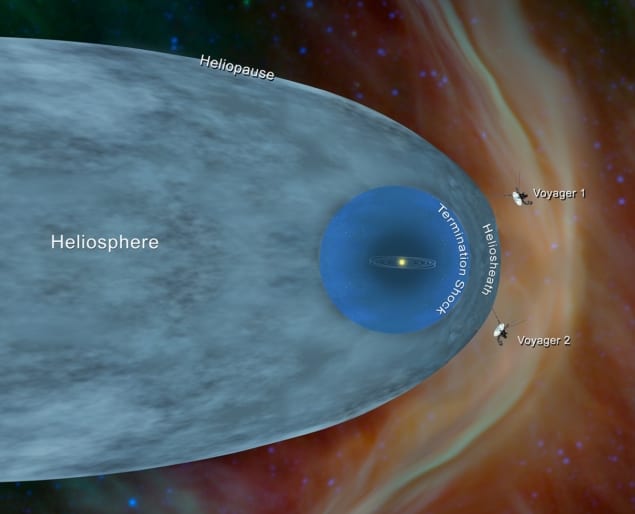
The spacecraft Voyager 2 left the heliosphere and travelled into interstellar space over the course of a day in November 2018, according to a suite of papers published today by scientists working on the mission.
The spacecraft was launched in 1977 along with its twin Voyager 1, which crossed-over into interstellar space seven years ago. Scientists analysing data from Voyager 2 have found both similarities and differences to the crossing of Voyager 1.
The Sun is surrounded by a huge bubble called the heliosphere that is inflated by the supersonic solar wind of charged particles emitted by the Sun. The edge of this bubble is called the heliopause, which is where the outgoing solar wind is halted by the interstellar wind of charged particles.
Different crossings
Both Voyager missions crossed the heliopause on the windward side of the bubble but at different locations. Voyager 1 left the northern hemisphere of the heliosphere and Voyager left the southern hemisphere at locations separated by about 160 au (1 au is the distance from Earth to the Sun).
Voyager 1’s departure point was about 122 au from the Sun, while Voyager 2 exited at 119 au from the Sun. According to scientists working on the Voyager 2 mission, these slightly different distances could be a result of the exit events occurring a different times in the 11-year solar cycle. This cycle changes involves changes in the intensity of the solar wind that could make the size of the heliosphere fluctuate.
One big difference between the two spacecraft is that all five instruments onboard Voyager 2 are still functioning, whereas the plasma instrument that measures the solar (and then interstellar) wind was damaged on Voyager 1 in 1980. This meant that Voyager 1 was unable to measure the transition from the hot, low-density solar wind to the cold, high-density interstellar wind.
Thinner and smoother
Analysis of the Voyager 2 data suggest that the heliopause it encountered was thinner and smoother than the boundary crossed by Voyager 1. Indeed, Voyager 2 made the crossing in less than one day. The Voyager 2 data also suggested that the interstellar medium that the spacecraft first encountered is hotter than had been expected.
Voyager 2 also discovered a region between the heliopause and interstellar space where the solar and interstellar winds interact. This layer was not detected by Voyager 1.

Voyager – a mission for life
Both spacecraft found little change in the direction and magnitude of magnetic fields across the heliopause. This is surprising because scientists had expected an abrupt transition between solar and interstellar magnetic fields to occur at the interface.
Gaining a better picture of the heliopause and heliosphere could provide important clues about how life emerged on Earth – and how it could emerge on exoplanets orbiting distant stars that would also be surrounded by bubbles. That is because the heliosphere shields Earth from many cosmic rays impinging on it – radiation that is harmful to life.
The Voyager 2 papers appear in Nature Astronomy.



